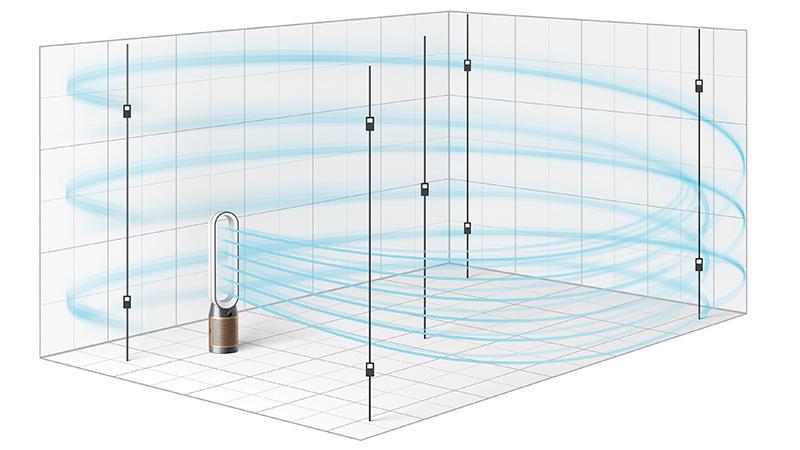Choose your model
Reviews powered by Bazaarvoice
Dyson Purifier Cool Formaldehyde™ TP09 (White/Gold)
Overall rating

We test beyond the industry standard. For real living spaces.
Dyson engineers designed the POLAR test to challenge the industry standard test methods - measuring purification, sensing, and circulation to ensure the whole room is purified properly.
-

Some CADR methods do not measure purification performance in a realistically-sized room.
In this 28.5m³ room, one fan mixes the air before the test, and another circulates air during the test. Only one sensor measures air quality.
-

Dyson's POLAR test goes further to measure purification throughout a realistically-sized room.
In this 81m³ room, there are no fans except the air purifier with nine different sensors to measure even-room air quality.

-
Common allergens - pet dander, pollen and dust
PM10
-
Nitrogen dioxide
Gas stoves and car exhausts
-
Industrial emissions and smoke
PM2.5
-
Ultrafine particles
PM0.1
-
Formaldehyde (HCHO)
Carpets, rugs and flooring
-
Odors
Household fumes and cooking
-
Benzene and VOCs
Cleaning products and candles





Get more from your Dyson with the MyDyson™ app▴
-
Control air quality, wherever you are
Control your air purifier from anywhere with your smart device, whether you’re traveling, at work, or simply at home on the sofa.
-
Monitor air quality. View reports, fast.
Monitor indoor and outdoor air quality from your smart device. See your machine’s activity as well as temperature, humidity, and filter reports.
-
Automated filter alerts
You’ll never need to worry about when to replace your filter. We’ll let you know. Helping your machine to always perform at its best.
▴The MyDysonTM app is only compatible with select Dyson products. For a list of compatible products, please click here.
Features
-

Backward airflow. Purifies without cooling you.
Airflow is diverted through the back of the machine, maintaining effective purification.
-

Cools you when needed³
Projects over 77 gallons of air a second for cooling airflow.
-

20% quieter
Acoustically engineered to reduce turbulence, so it's 20% quieter than the previous model.
-

Easy filter care
The catalytic filter never needs to be replaced. We recommend replacing the HEPA+Carbon filter when you're alerted by the MyDyson app or every 12 months, whichever comes first.
-

Night mode
For lighter sleepers, it monitors and purifies using the quietest settings along with a dimmed display.
Featured air treatment articles
-
Cleaner air, cleaner home: how to maintain a healthier space during home renovations
Moving and home makeovers involve new furniture and paint, which could add to the levels of a potentially harmful pollutant called formaldehyde in the home. Here's how to maintain a healthier space during moves and renovations.
-
Formaldehyde: the invisible indoor pollutant
Although the smell of new paint might fade over time, the emission of potentially harmful gases, such as formaldehyde, can persist. Pollutants like these can continuously ‘off-gas’ for a number of years – but what exactly is formaldehyde and why is it in our homes?
-
Allergens
An allergen is a substance that can cause an allergic reaction by triggering the body’s immune system. Common indoor allergens include pet dander and pollen.¹⁰
-
Bacteria
Microscopic, single-celled organisms that can exist in their millions, in every environment. Not all bacteria are harmful, but some can have adverse effects, such as E. coli.¹⁰
-
Benzene
Benzene is colorless, flammable liquid produced by both natural and man-made processes. It’s a natural part of crude oil, gasoline, and cigarette smoke. Indoors, it comes from products such as glues, paints, furniture wax, and detergents.
-
Carbon dioxide (CO₂)
A colorless greenhouse gas, which comes from the extraction and burning of fossil fuels. Increased CO₂ levels can impact cognitive function.
-
Formaldehyde
This colorless, flammable gas is used in some building materials and household products. Sources can include some fabrics found in flooring and furniture, glues, paints, varnishes, air fresheners, and household cleaners.
-
HEPA 13
HEPA (High Efficiency Particulate Air) is an air filter efficiency standard and a measure of a filter’s performance. To achieve this standard, filters must meet a minimum of 99.95 per cent particle removal at the most penetrating particle size.
-
Humidification
A process of increasing air moisture content through the addition of water vapor or steam. Humidifiers can add moisture to the air in dry conditions, creating a more comfortable indoor environment when needed.
-
Microns
Airborne particles are usually described in microns. One micron is equal to one-millionth of a meter. The human eye can see debris and dust that are approximately 25 microns in size.
-
Nitrogen dioxide (NO₂)
Nitrogen dioxide is a liquid below 70.2°F and a gas at higher temperatures. It is toxic to humans in both states in high concentrations. Gas stoves and space heaters are the most common indoor sources of NO₂ emissions. Other sources include improperly vented furnaces and water heaters.
-
Pet dander
Pet dander is made up of tiny particles of skin, saliva and urine, shed by animals with fur or feathers. Pet dander lingers in the air before settling on surfaces such as furniture, bedding, and fabrics. Exposure to these airborne particles can trigger allergies.¹⁰
-
Particulate matter (PM)
Particulate matter contains microscopic solids or liquid droplets, measured in microns. Indoor PM can be generated through many day-to-day activities such as cooking, cleaning, and the burning of candles and fires.
-
Purification
The process of reducing unwanted contaminants. Air purification is intended to remove airborne pollutants. Depending on the method, air purification can remove dust, allergens, or viruses.10
-
Volatile organic compounds (VOCs)
Volatile organic compounds are potentially harmful gases found in many household products. Common sources include paints, varnishes, air fresheners, cosmetics, and cleaning products.
-
Pollen
Pollen is a powdery substance released from seed plants as part of their reproduction process. It typically appears from trees in the spring, grasses in the summer, and weeds in the autumn. Pollen grains are among the most common allergens.¹⁰
-
Aspergillus mold
A common name for a visible group of fungi, mold thrives wherever there is dampness – sending out millions of spores into the air. Exposure to mold occurs via inhalation, skin contact, or ingestion.¹⁰
-
-
Frequently asked questions
Dyson engineers are perfectionists. Channeling our relentless dissatisfaction, we have re-engineered our latest purifiers to be fully sealed to HEPA H13 standard.⁹ Two phases of purification sit within a fully-sealed filtration and airflow system to trap pollutants inside, preventing them from leaking back into the air you breathe. This machine is also 20% quieter than previous models, achieving lower sound output without any compromise to purification performance.
The Dyson Purifier Formaldehyde range has all of the capabilities found in our advanced purification products, but goes a step further to detect and destroy formaldehyde.⁺ An added solid-state sensor precisely detects formaldehyde, while our catalytic filter breaks it down into two safer molecules – carbon dioxide and water.
Formaldehyde is a polluting gas formed of carbon, hydrogen, and oxygen that is commonly found in homes. Sources of formaldehyde in your home could include paint and varnishes, air fresheners, mattresses, furniture, household cleaners, carpets, particleboard and plywood, electronics, dryer sheets, nail polish remover, moth balls, toys, fireplaces, and wood burning stoves.
HEPA grades refer to filtration effectiveness for specific sizes of airborne particles. HEPA H13 is a filter with 99.95% removal of the specific particle size that most readily makes it through that specific filter. Dyson filters also capture 99.97% of particles down to 0.3 microns in size, including common pollutants such as allergens*, dust, and smoke particulates.
We recommend replacing the HEPA+Carbon filter roughly every 12 months, depending on how often you use it. That’s because over time filters can become clogged with pollutants and even let unpleasant odors back into the room. The machine will alert you when it’s time to change filters. A filter life reading can be found on the LCD screen and via the MyDyson app.⁵ The catalytic filter never needs replacing.
No, TP09 can serve as a fan, which can help cool you. It is not an air conditioner.
Dyson purifiers capture wildfire smoke.¹¹
-
Replacement filter

*Allergens refers to nonliving material.
⁺Third party full machine testing based on GB/T 18801-2018 formaldehyde cumulative clean mass testing with continuous injection until plateau of formaldehyde CADR is achieved. Results may vary in practice.
³Fan; not air conditioning unit
⁵Requires device to run app, Wi-Fi or mobile data, Bluetooth 4.0 support, and iOS version 10 or Android version 5 (or above). Standard data and messaging rates may apply. Refer to the MyDyson app for compatible voice services.
⁸Tested in maximum setting for air projection, tested in Auto mode for purification coverage.
⁹Particle challenge by DEHS oil specified in EN1822 within a chamber specified in ASTM F3150.
¹⁰Not intended as a product claim. Refer to individual Dyson models for specific capture claims.
11Based on capture of particles, ammonia, benzene, and acetic acid.
Apple and the Apple logo are trademarks of Apple Inc., registered in the U.S. and other countries.
App Store is a service mark of Apple Inc., registered in the U.S. and other countries.
Google Play and the Google Play logo are trademarks of Google Inc.


















